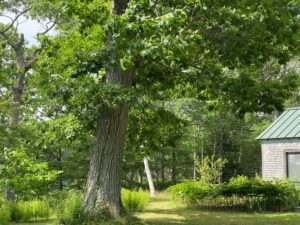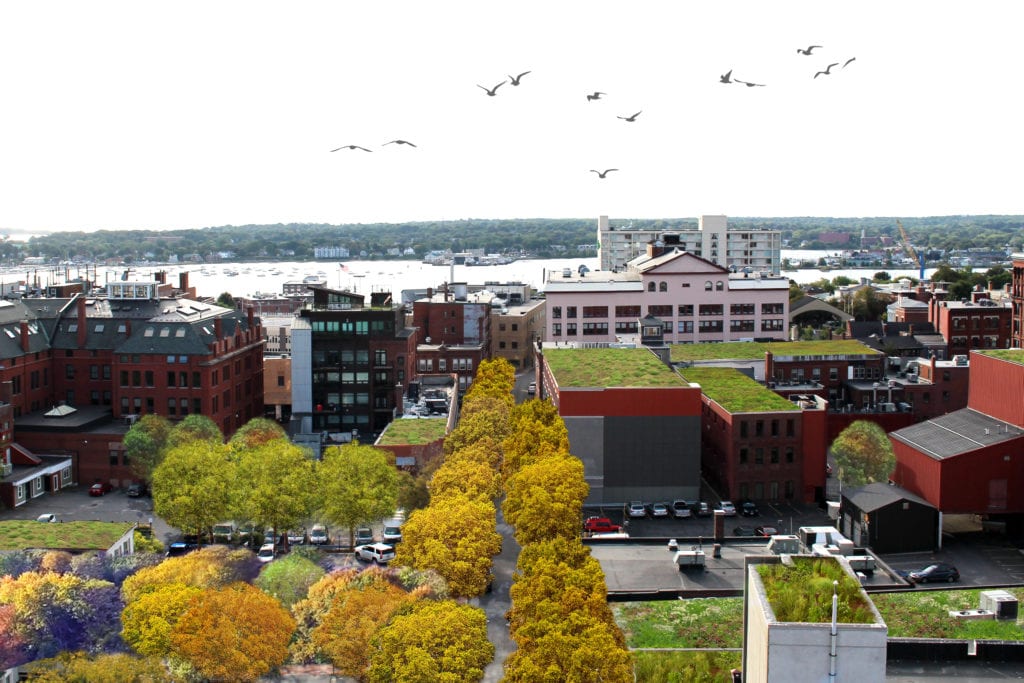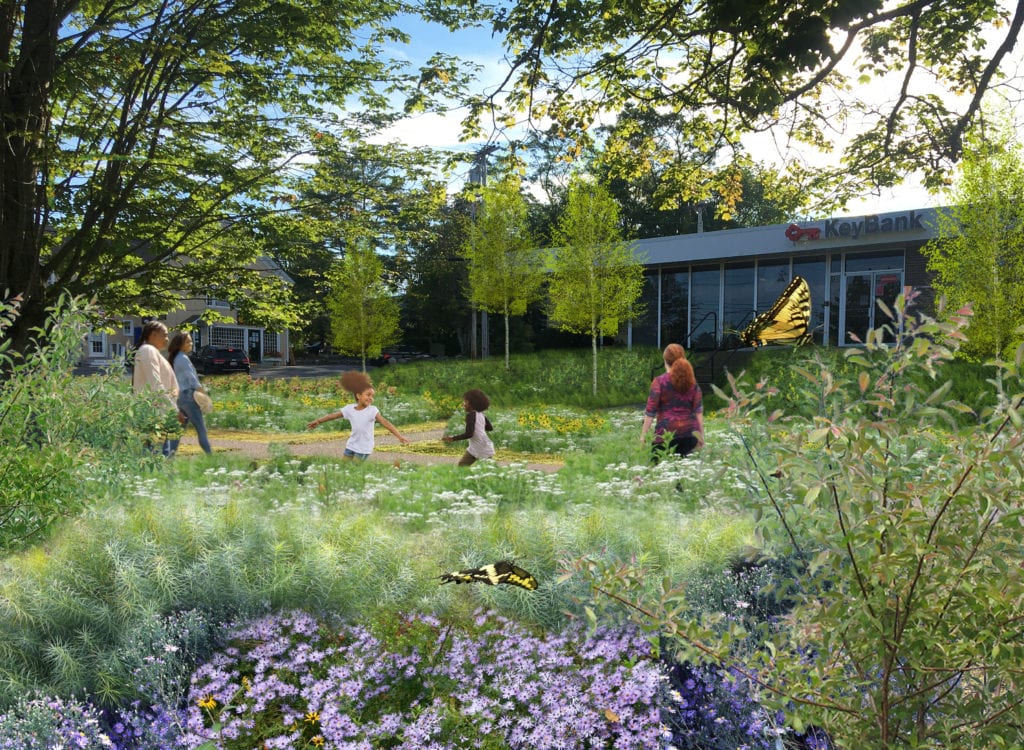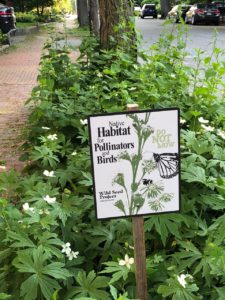Anna Fialkoff will present Rewild in 10 Action Steps at ELA’s Conference & Eco-Marketplace on March 4.
by Heather McCargo and Anna Fialkoff
Original article on the Wild Seed Project website here *All Images by Wild Seed Project, unless otherwise noted.
The term rewilding first appeared in the conservation world in the 1980s with a continental-scale vision to protect large tracts of wilderness and connect these areas with migration corridors. Biologists recognized the important role of wide-ranging large carnivores in maintaining the health of the whole landscape by controlling populations of grazing animals that they prey on. Yellowstone National Park is a case in point. After a century of wolves being absent, the landscape had been severely overgrazed by elk. In 1995, wolves were reintroduced into the park and, within a decade, vegetation returned, and a diversity of wildlife now thrive.
At Wild Seed Project, we consider rewilding to be not just for the large wilderness areas or charismatic megafauna like wolves. We focus our efforts on actions that people can take right outside their door. Rewilding is also a deliberate shift from human-centered, intensively managed landscapes to humans sharing their lands with the rest of nature. It is an intentional practice of restoring native plants in urban, suburban, and rural landscapes to reverse habitat loss, support ecosystems services, and bring nature back into our daily lives.
Rewilding begins with recognizing native plants as the basis of the local food web. Native plants are essential for populations of insects that in turn support birds, which serve as the bellwether of ecological health and resiliency. Recent research by University of Delaware biologist Doug Tallamy demonstrates that for a place to support a diversity of life, native plant species must represent at least 70% of the biomass in the landscape. Below this critical threshold, food webs collapse, and habitats unravel.
Below are collections of images to help you visualize how you might rewild a wide variety of places.
Reimagine Cities and Suburbs Through the Rewilding Lens
When reimagined through the rewilding lens, the vast expanses of (rather sterile) pavement and lawn in cities and suburbs can be transformed into habitat for both people and wildlife and help rekindle the sense of wildness and connection to the natural world that we crave.
- Portland, ME Reimagined. Native street trees cool the city, clean the air, store carbon, soak up water and support an abundance of insects and birds.
- Rendering by Julia Frederick, Landscape Architect.
- An urban backyard transformed into a verdant retreat for people and pollinators.
- Rendering by Ngoc Doan, designer and landscape photographer.
- A suburban residence is envisioned as a productive and edible landscape using native plants.
- Rendering by Jessica Alpert, Landscape Designer.
- Native grasses, wildflowers, shrubs, and trees absorb rainwater and provide a pollinator habitat while making a strip mall parking lot a more pleasant place to be.
- Rendering by Alec Spangler, Assistant Professor of Landscape Architecture at Penn State.
- A bank’s empty lawn reimagined as a three-dimensional landscape and ground covers for both people and wildlife to enjoy
- Rendering by Julia Frederick, Landscape Architect.
- An empty parking lot behind a diner becomes a beloved neighborhood park.
- Rendering by Laura Gomez, Landscape Designer.
 Plant native trees
Plant native trees
Native species of oaks, cherries, willows, birches, poplars, and elms are found to support the widest variety of life. Since trees produce such a large volume of leaves that insects rely on as a food source, they are in turn essential to feeding songbirds with a bounty of protein-rich caterpillars. The sheer amount of vertical mass we’ll get from planting native trees will carry us toward our rewilding goal of 70% native plant biomass in leaps and bounds.
Shrink your lawn: Replace it with meadows and layered plantings
Rather than letting resource-sucking lawns dominate the bulk of our yards, they can instead be used sparingly and purposefully, such as for recreation or as pathways that convey us through the landscape. Urban and suburban lawns can be mostly converted into meadows, or other types of layered plantings with trees, shrubs, and ground covers to feed pollinators, birds, and other wildlife
Preserve What’s Already There
Restoring native plants is not just about planting but also preserving existing native vegetation. Sometimes mowing less or removing invasive plants is all that is needed to encourage native plants to make a comeback and return these landscapes to the vibrant species-rich places they once were.

Native meadows, hedgerows, and woodlands on rural farmland support food systems for people and wildlife.

Preserving existing native trees, shrubs and ground covers keeps critical biomass in the landscape and provides essential forage and shelter for insects, birds, and mammals.

Existing woodlands are high-value carbon sinks and support a wide variety of creatures as well as capture and store rainwater. Please protect them.
Does It Have to Look Wild to be Rewilded?
Rewilding can look intentional and ornamental while still providing essential ecosystem services. Well-defined edging and beautifully arranged textures, layers, flowers, and fruits set gardens apart from more wild spaces. They are made more ecologically functional by adding a diversity of native plants and using more wildlife-friendly practices, such as eliminating the use of pesticides, fertilizers and keeping natural leaf litter intact. How we manage our native plantings will determine whether we can sustain and support the life-cycles and successful reproduction of butterflies, moths, bees, birds, salamanders, frogs, and many more organisms.
- Beautiful Urban Front Garden
- Brick patio surrounded by native plants
No Land of Your Own? Yes, You Too Can Be a Rewilder.
You don’t need land of your own to be a rewilder! Adopt a street tree to care for, tend a sidewalk hellstrip, display native containers on your stoop, plant a window box with natives, encourage your favorite restaurant or place of business to add native plants to their outdoor spaces, or make your community garden plot into a safe haven for butterflies and birds.
 Inspire Through Your Example
Inspire Through Your Example
It can be intimidating to talk to your neighbors, friends, and family about the need to plant natives for habitat creation, and it can be even more difficult to ask others to change their landscape practices. One way to spark conversation in a non-confrontational way is to put up a yard sign that offers insight into the work you are doing. Curious passersby will stop and ask questions if they like what they see. You can start by inspiring others through your example.
Join the Movement: Take the Pledge to Rewild
As we face the unprecedented, urgent, and entwined challenges of the climate crisis and biodiversity loss, you can be part of the solution when you Pledge to Rewild. When you take the pledge, Wild Seed Project will share practical tools and resources to guide you through rewilding. This is a holistic process of restoring native plants to the landscape, shifting away from harmful landscape practices, and engaging your community in this ongoing cooperative effort. We hope to inspire a movement to build momentum toward our shared vision of bringing back nature where we live.
Further Reading
- Rewilding Maine Landscapes, released in March 2020, outlines Wild Seed Project’s planned impact over the next decade.
- To learn more about rewilding movements in the US and abroad, visit Rewilding Earth, Rewilding Europe, Rewilding Britain, and Biophilic Cities.
- Douglas Tallamy’s books Bringing Nature Home and Nature’s Best Hope provide scientific backing and inspiration for the Pledge to Rewild. Learn more on the Homegrown National Park website.
About the Authors
Heather McCargo, MA is the Founder and Executive Director of WildSeed Project. Heather is an educator with 30 years of experience in plant propagation, landscape design, horticulture, and conservation. A former head plant propagator at the New England Wild Flower Society’s Garden in the Woods during the 1990s, Heather has also worked at several landscape architecture/planning firms specializing in ecological design and has contributed to research projects with USAID, the National Gardening Association, and MOFGA. She has lectured nationally and is widely published in journals and magazines such as Brooklyn Botanical Garden’s “Growing from Seed,” Horticulture, American Nurseryman, Ecological Landscape Alliance, and many others. More locally, Heather designed the master plan for the medicinal gardens at Avena Botanicals in Rockport and was the creator of the Bay School Agricultural Arts program in Blue Hill. Heather has a BA in plant ecology from Hampshire College and an MA from the Conway School of Landscape Design.
As the new program manager, Anna Fialkoff is ready to help Wild Seed Project further its educational programming, deepen relationships with partner organizations, and catalyze a movement to rewild Maine. Anna was most recently Senior Horticulturist at Native Plant Trust’s Garden in the Woods in Framingham, MA, where she designed and installed native plant gardens, managed interns and volunteers, and taught the public ways to incorporate native plants in their own gardens. With a BA in Human Ecology from College of the Atlantic and an MS in Ecological Design from The Conway School, she brings with her a deep knowledge of native plant ecology, horticulture, conservation, and ecological landscape design.
***
Each author appearing herein retains original copyright. Right to reproduce or disseminate all material herein, including to Columbia University Library’s CAUSEWAY Project, is otherwise reserved by ELA. Please contact ELA for permission to reprint.
Mention of products is not intended to constitute endorsement. Opinions expressed in this newsletter article do not necessarily represent those of ELA’s directors, staff, or members.













 Plant native trees
Plant native trees














 Inspire Through Your Example
Inspire Through Your Example